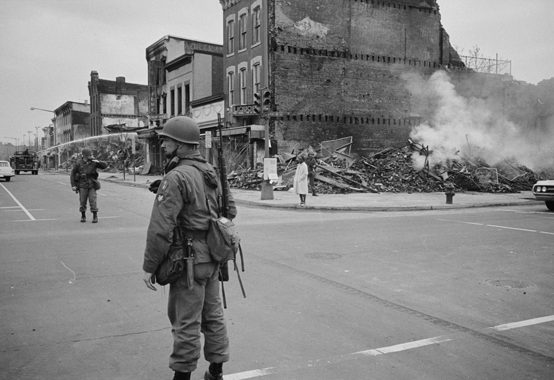City of Good Intentions

Sometimes it seems like the nation’s capital is really two cities: dateline Washington and hometown DC. The current show at the Smithsonian’s Anacostia Community Museum, “Twelve Years that Shook and Shaped Washington: 1963 – 1975,” is an attempt to bridge the gap–or at least to give official Washington’s view of unofficial DC.
The show is one of those “social history” grab-bags: a display about public colleges here, a selection of dashikis there. We get morsels of a lot of things but few full dishes. Why isn’t there any video in the section on black dance and theater? Why not let us hear some go-go, the native form of funk born toward the tail end of the show’s timeline? Why are all the photos printed onto deeply-colored backgrounds, making them blurry and inartistic?
But as you move through the meandering exhibit, a few arguments do emerge.
The timeline is itself an argument. Why twelve years, and why these twelve? 1963 is an especially odd starting year, which is one reason the show doesn’t really start there–it opens with JFK’s inauguration, Marian Anderson singing the national anthem on the steps of the Lincoln Memorial. But the timeline basically covers the early years of the District’s limited home rule: In 1961 the 23rd Amendment gave DC residents the right to vote for President, and by 1975 we were allowed the privilege of electing our own personal mayor.
I grew up hearing a different timeline for the city: 1968 through roughly 1994. In this story, the city I knew was born the day Martin Luther King, Jr. was assassinated. Riots broke out in the District and large swathes of the city’s black middle-class neighborhoods burned for days. Tanks rolled through the streets and the National Guard patrolled; an exodus to the suburbs left large portions of the riot zone burnt out for the next 25 years.
By contrast, this show downplays the riots. There are a couple photos of burnt-out storefronts and National Guardsmen, but you don’t get any sense of the scope of the destruction in either space or time. A more powerful–and more honest–exhibit would include a map showing everywhere the fires burned. Even more powerful would be photos of the same street corners in late April 1968 and late April 1995: Many of them would look almost the same except for the hemlines.
But the Anacostia Museum makes a strong case for not allowing the spectacle of the riots to control the narrative. “Twelve Years” gets a lot of mileage out of starting earlier. Its most powerful sections, unexpectedly, concern urban renewal, aka displacement of the poor. These early section depicts the razing of Southwest amid promises that the displaced black residents would be given better, modern housing elsewhere, and the “fight against the freeways.” A poster proclaims, “White Man’s Road… Thru Black Man’s Home!”
A 1948 chart–the “1963” starting point is ephemeral–argues that urban renewal is “How Negroes became displaced persons.” Black neighborhoods were uprooted and recreated in Northeast and Anacostia–without the institutions and relationships which had sustained people during the bad old days. A wistful photograph by Garnet Wolesley Jex shows a lone black girl in the middle distance with her back to the camera, her dress blown sideways in the wind, amid the storefronts of a vanished DC. A phenomenal short film called “No Time for Ugliness” gives the argument against “urban sprawl, the careless misuse of land, unregulated and unrestrained,” in scolding white voice-over. Once, there was ugliness. Now there are white children!
“Will we have disorder or design? Ugliness or beauty?” “Twelve Years” gives a subtle and compelling argument that attempts to impose order provoke multiple forms of disorder–and that terms like “disorder” and “disruption” should be applied to the actions of lawmakers at least as often as they’re applied to lawbreakers.
This Smithsonian-vetted history sometimes reveals more than it intends–either about the historical events it records, or about the perspectives and blind spots of the curators. In the first camp is the section on feminism. What leaps out at a conservative viewer is the centrality of abortion in the photos chosen to depict the ’70s women’s movement.
The most notable lacuna to me was the near-absence of religion. Churches appear only in their role as seedbeds of political organization. Judaism appears in a photo of the Adas Israel Synagogue being moved in its entirety out of the path of construction. The specifically religious stories of the ’60s and ’70s are absent.
There are other absences: criminal DC, the world of speakeasies and sex work and our enduring drug economy; Southern-transplant DC, both black and white. Basically what you won’t find here is the District you’ll encounter on your local city bus: where one rider tries to lead a kind of rolling tent revival, another reminisces about the good old days when you could run into Marvin Gaye at the after-hours club, and another says kids don’t respect their elders now that they’ve banned paddling in the schools.
“Twelve Years” presents a nuanced view of an era in which it seemed like nuance was being rationed for the war effort. It’s well-meaning, like so many governmental and philanthropical interventions in the District. If it fails to take seriously the less-liberal and less-secular longings of hometown DC, well, that is informative in its own way.
Eve Tushnet is a TAC contributing editor, blogs at Patheos.com, and is the author of Gay and Catholic: Accepting My Sexuality, Finding Community, Living My Faith, as well as the author of the newly released novel Amends, a satire set during the filming of a reality show about alcohol rehab. “New Urbs” is supported by a grant from the Richard H. Driehaus Foundation.
Comments